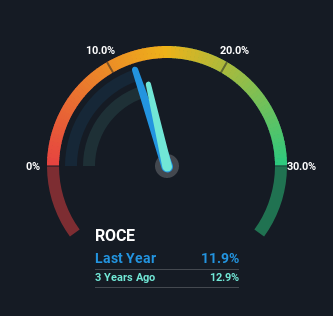If we want to find a stock that could multiply over the long term, what are the underlying trends we should look for? In a perfect world, we'd like to see a company investing more capital into its business and ideally the returns earned from that capital are also increasing. Basically this means that a company has profitable initiatives that it can continue to reinvest in, which is a trait of a compounding machine. That's why when we briefly looked at HIL's (NSE:HIL) ROCE trend, we were pretty happy with what we saw.
What Is Return On Capital Employed (ROCE)?
For those who don't know, ROCE is a measure of a company's yearly pre-tax profit (its return), relative to the capital employed in the business. Analysts use this formula to calculate it for HIL:
Return on Capital Employed = Earnings Before Interest and Tax (EBIT) ÷ (Total Assets - Current Liabilities)
0.12 = ₹1.8b ÷ (₹21b - ₹6.6b) (Based on the trailing twelve months to December 2022).
Therefore, HIL has an ROCE of 12%. On its own, that's a standard return, however it's much better than the 9.2% generated by the Basic Materials industry.
Check out our latest analysis for HIL

In the above chart we have measured HIL's prior ROCE against its prior performance, but the future is arguably more important. If you're interested, you can view the analysts predictions in our free report on analyst forecasts for the company.
So How Is HIL's ROCE Trending?
While the returns on capital are good, they haven't moved much. The company has consistently earned 12% for the last five years, and the capital employed within the business has risen 122% in that time. 12% is a pretty standard return, and it provides some comfort knowing that HIL has consistently earned this amount. Stable returns in this ballpark can be unexciting, but if they can be maintained over the long run, they often provide nice rewards to shareholders.
In Conclusion...
The main thing to remember is that HIL has proven its ability to continually reinvest at respectable rates of return. And the stock has followed suit returning a meaningful 45% to shareholders over the last five years. So while investors seem to be recognizing these promising trends, we still believe the stock deserves further research.
One more thing to note, we've identified 2 warning signs with HIL and understanding these should be part of your investment process.
If you want to search for solid companies with great earnings, check out this free list of companies with good balance sheets and impressive returns on equity.
Valuation is complex, but we're here to simplify it.
Discover if BirlaNu might be undervalued or overvalued with our detailed analysis, featuring fair value estimates, potential risks, dividends, insider trades, and its financial condition.
Access Free AnalysisHave feedback on this article? Concerned about the content? Get in touch with us directly. Alternatively, email editorial-team (at) simplywallst.com.
This article by Simply Wall St is general in nature. We provide commentary based on historical data and analyst forecasts only using an unbiased methodology and our articles are not intended to be financial advice. It does not constitute a recommendation to buy or sell any stock, and does not take account of your objectives, or your financial situation. We aim to bring you long-term focused analysis driven by fundamental data. Note that our analysis may not factor in the latest price-sensitive company announcements or qualitative material. Simply Wall St has no position in any stocks mentioned.
About NSEI:BIRLANU
BirlaNu
Engages in the production and distribution of building materials and other solutions in India and internationally.
Undervalued second-rate dividend payer.
Similar Companies
Market Insights
Community Narratives



